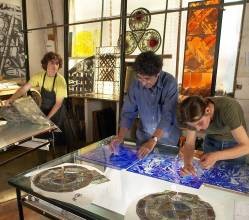Are Younger Generations Interested In Continuing Traditional Crafts? Absolutely! While globalization presents challenges, younger generations are finding innovative ways to revitalize and sustain these invaluable skills. SIXT.VN understands the importance of preserving Vietnamese cultural heritage and connects travelers with experiences that support local artisans. By choosing SIXT.VN, you’re not just exploring Vietnam; you’re investing in its future, helping to preserve heritage tourism, cultural preservation, and community development.
1. What Challenges Do Traditional Crafts Face Today?
Traditional crafts encounter numerous obstacles in today’s world. Globalization and mass production provide cheaper alternatives, making it difficult for artisans to compete. According to research from the United Nations Educational, Scientific and Cultural Organization (UNESCO) in 2003, safeguarding attempts should instead concentrate on encouraging artisans to continue to produce craft and to pass their skills and knowledge onto others, particularly within their own communities.
1.1 The Impact of Globalization and Mass Production
Mass production often wins on price and speed. This puts significant pressure on traditional craftspeople who dedicate time and skill to create unique, handmade items.
1.2 Environmental Concerns and Resource Depletion
Deforestation and land clearing reduce the availability of natural resources crucial for many crafts. This can lead to unsustainable practices and further endanger traditional techniques.
1.3 Changing Social Conditions and Cultural Tastes
As societies evolve, the demand for traditional crafts can diminish. Festivals and celebrations may become less elaborate, reducing opportunities for artisans to showcase their skills.
1.4 Lack of Interest from Younger Generations
Young people may find the apprenticeship process too demanding. They often seek employment in industries offering better pay and less stringent requirements.
1.5 Risk of Losing Trade Secrets
Many crafts rely on trade secrets passed down through generations. If younger family members are not interested, this knowledge may disappear.
 Woodcrafting Knowledge
Woodcrafting Knowledge
2. How Are Traditional Crafts Being Safeguarded?
Safeguarding traditional crafts involves various strategies aimed at ensuring the knowledge and skills are passed on to future generations. This allows crafts to thrive, providing livelihoods and reflecting cultural creativity.
2.1 Strengthening Traditional Instruction and Apprenticeship Systems
One effective method is offering financial incentives to students and teachers. This makes knowledge transfer more appealing and sustainable.
2.2 Reinforcing Local Markets and Creating New Opportunities
Supporting local markets for craft products is crucial. At the same time, new markets can be created by appealing to those who appreciate handmade objects rich in cultural value.
2.3 Sustainable Resource Management
Replanting trees and implementing sustainable practices help offset environmental damage. Legal measures may also be necessary to protect communities’ access to resources.
2.4 Legal Protections for Traditional Crafts
Intellectual property protections, patents, and copyright registrations can help communities benefit from their traditional crafts and motifs.
2.5 Encouraging Craft Production Through Legislation
Local bans on wasteful products, such as plastic bags, can stimulate markets for handmade alternatives. This allows traditional skills to flourish.
 Indonesian Kris
Indonesian Kris
3. What Is the Role of Technology in Preserving Traditional Crafts?
Technology plays a crucial role in revitalizing and preserving traditional crafts. It offers new avenues for artisans to connect with wider audiences and adapt to modern markets.
3.1 E-Commerce and Online Marketplaces
Online platforms allow artisans to sell their products globally. This expands their customer base and increases revenue, making the craft more sustainable.
3.2 Digital Documentation and Preservation
Technology can document traditional techniques and designs. This ensures that knowledge is preserved for future generations.
3.3 Social Media and Promotion
Social media platforms provide artisans with tools to showcase their work. They can engage with customers, share their stories, and build a following.
3.4 Online Education and Workshops
Online courses and workshops make it easier for people to learn traditional crafts. This expands the pool of potential artisans and enthusiasts.
3.5 3D Printing and Innovation
3D printing can be used to create tools and molds needed for traditional crafts. This helps to streamline the production process without sacrificing authenticity.
4. How Can Tourism Support Traditional Crafts in Vietnam?
Tourism can significantly contribute to the preservation of traditional crafts in Vietnam. By supporting local artisans and promoting cultural heritage, tourism can create sustainable livelihoods and foster cultural exchange.
4.1 Promoting Craft Villages and Workshops
Highlighting craft villages and workshops as tourist destinations encourages visitors to learn about and purchase local crafts. This provides artisans with direct income and recognition.
4.2 Offering Craft-Based Tourism Experiences
Organizing workshops, demonstrations, and tours focused on traditional crafts allows tourists to engage with the local culture and learn new skills.
4.3 Partnering with Local Artisans
Hotels, tour operators, and travel agencies can partner with local artisans to offer authentic experiences. This creates a mutually beneficial relationship that supports the local economy.
4.4 Ensuring Fair Trade Practices
Promoting fair trade practices ensures that artisans receive fair prices for their products. This helps to improve their livelihoods and encourages them to continue their craft.
4.5 Educating Tourists About the Importance of Traditional Crafts
Providing information about the cultural significance and economic impact of traditional crafts can encourage tourists to support local artisans and make responsible purchasing decisions.
5. What Are Some Examples of Successful Craft Preservation Initiatives?
Several successful initiatives around the world demonstrate how traditional crafts can be preserved and revitalized. These examples offer valuable lessons and inspiration.
5.1 The “Maitre d’art” Program in France
This program pairs master artisans with apprentices to ensure the transmission of rare skills. It provides financial support and recognition to both masters and apprentices.
5.2 The Revitalization of Navajo Weaving in the United States
Efforts to promote and preserve Navajo weaving have helped to sustain this traditional craft. Initiatives include educational programs, marketing support, and fair trade practices.
5.3 The Preservation of Traditional Pottery in Japan
In Japan, traditional pottery techniques are protected through government programs and cultural designations. This ensures that these skills are passed on to future generations.
5.4 The Support of Handloom Weaving in India
Various initiatives support handloom weavers in India, including financial assistance, marketing support, and the promotion of handloom products.
5.5 The Development of Craft Tourism in Peru
Peru has successfully developed craft tourism, attracting visitors who are interested in learning about and purchasing local crafts. This has helped to create sustainable livelihoods for artisans.
 The Maître d’art
The Maître d’art
6. What Skills Are Involved in Creating Craft Objects?
Creating craft objects involves a wide array of skills, ranging from delicate and detailed work to robust and rugged tasks. The specific skills depend on the craft and the materials used.
6.1 Delicate and Detailed Work
Producing paper votives, intricate jewelry, and fine textiles requires precision and attention to detail.
6.2 Robust and Rugged Tasks
Creating sturdy baskets, thick blankets, and durable tools involves physical strength and practical knowledge.
6.3 Specialized Techniques
Many crafts require specialized techniques, such as wood carving, pottery making, and metalworking. These techniques often involve years of training and practice.
6.4 Knowledge of Materials
Artisans must have a deep understanding of the materials they use, including their properties, strengths, and limitations.
6.5 Design and Aesthetics
Craft objects often reflect cultural values and aesthetic traditions. Artisans must have a strong sense of design and aesthetics to create visually appealing and meaningful objects.
7. How Do Craft Traditions Adapt to Modern Markets?
Adapting craft traditions to modern markets requires innovation and creativity. Artisans must find ways to appeal to contemporary consumers while preserving the authenticity of their craft.
7.1 Incorporating Modern Designs and Techniques
Integrating modern designs and techniques into traditional crafts can make them more appealing to contemporary consumers.
7.2 Using Sustainable and Eco-Friendly Materials
Using sustainable and eco-friendly materials can attract environmentally conscious consumers.
7.3 Collaborating with Designers and Brands
Collaborating with designers and brands can help artisans reach new markets and gain recognition.
7.4 Focusing on Quality and Craftsmanship
Emphasizing the quality and craftsmanship of handmade objects can differentiate them from mass-produced items.
7.5 Telling the Story Behind the Craft
Sharing the story behind the craft, including its history, cultural significance, and the artisan’s personal journey, can create a deeper connection with consumers.
8. What Can Governments Do to Support Traditional Crafts?
Governments play a crucial role in supporting traditional crafts through policy, funding, and promotion.
8.1 Providing Financial Assistance and Grants
Offering financial assistance and grants to artisans can help them invest in their businesses and improve their livelihoods.
8.2 Establishing Training and Apprenticeship Programs
Creating training and apprenticeship programs can ensure that traditional skills are passed on to future generations.
8.3 Promoting Craft Tourism
Promoting craft tourism can attract visitors who are interested in learning about and purchasing local crafts.
8.4 Protecting Intellectual Property Rights
Protecting intellectual property rights can help artisans benefit from their traditional designs and techniques.
8.5 Supporting Craft Organizations and Associations
Supporting craft organizations and associations can provide artisans with resources, networking opportunities, and advocacy.
9. What Are the Benefits of Preserving Traditional Crafts?
Preserving traditional crafts offers numerous benefits, including economic, cultural, and social advantages.
9.1 Economic Benefits
Traditional crafts can create jobs, generate income, and contribute to economic growth.
9.2 Cultural Benefits
Preserving traditional crafts helps to maintain cultural identity, promote cultural diversity, and safeguard cultural heritage.
9.3 Social Benefits
Traditional crafts can foster social cohesion, promote community development, and provide opportunities for personal growth and creativity.
9.4 Environmental Benefits
Sustainable craft practices can help to protect the environment and promote responsible resource management.
9.5 Tourism Benefits
Traditional crafts can enhance the tourism experience, attract visitors, and generate revenue for local communities.
10. How Does SIXT.VN Support Cultural Tourism in Vietnam?
SIXT.VN supports cultural tourism in Vietnam by offering services that connect travelers with authentic cultural experiences. We understand the importance of preserving Vietnamese heritage and work to promote sustainable tourism practices.
10.1 Curated Cultural Tours
SIXT.VN offers curated cultural tours that highlight traditional crafts, historical sites, and local customs. These tours provide travelers with a deeper understanding of Vietnamese culture.
10.2 Partnerships with Local Artisans
We partner with local artisans to offer unique experiences, such as craft workshops and demonstrations. This provides artisans with income and exposure.
10.3 Sustainable Tourism Practices
SIXT.VN is committed to sustainable tourism practices that minimize environmental impact and support local communities.
10.4 Convenient Transportation Services
We offer convenient transportation services, including airport transfers and private car rentals, making it easy for travelers to explore Vietnam’s cultural destinations.
10.5 Hotel Booking Assistance
SIXT.VN provides hotel booking assistance, helping travelers find accommodations that support local businesses and promote cultural exchange.
Planning a trip to Vietnam? Let SIXT.VN help you explore the country’s rich cultural heritage while supporting local artisans. Visit our website at SIXT.VN or contact us via Hotline/Whatsapp at +84 986 244 358 to learn more about our services. Our address is 260 Cau Giay, Hanoi, Vietnam. Discover the convenience, reliability, and personalized support that SIXT.VN offers, making your journey unforgettable. Book your adventure today and be part of preserving Vietnam’s traditional crafts!
FAQ: Traditional Crafts and Younger Generations
1. Why are traditional crafts important?
Traditional crafts are important because they preserve cultural heritage, provide livelihoods, and foster creativity. They represent the accumulated knowledge and skills of generations.
2. What are the main challenges facing traditional crafts today?
The main challenges include globalization, mass production, environmental concerns, changing social conditions, and a lack of interest from younger generations.
3. How can technology help preserve traditional crafts?
Technology can help through e-commerce, digital documentation, social media promotion, online education, and innovative tools like 3D printing.
4. What is the role of tourism in supporting traditional crafts?
Tourism can support traditional crafts by promoting craft villages, offering craft-based experiences, partnering with local artisans, and educating tourists about the importance of these crafts.
5. What can governments do to support traditional crafts?
Governments can provide financial assistance, establish training programs, promote craft tourism, protect intellectual property rights, and support craft organizations.
6. How can younger generations get involved in traditional crafts?
Younger generations can get involved by participating in apprenticeships, attending workshops, using technology to promote crafts, and supporting local artisans.
7. What are some examples of successful craft preservation initiatives?
Examples include the “Maitre d’art” program in France, the revitalization of Navajo weaving in the United States, and the preservation of traditional pottery in Japan.
8. How can traditional crafts adapt to modern markets?
Traditional crafts can adapt by incorporating modern designs, using sustainable materials, collaborating with designers, focusing on quality, and telling the story behind the craft.
9. What are the benefits of preserving traditional crafts?
The benefits include economic growth, cultural preservation, social cohesion, environmental sustainability, and enhanced tourism.
10. How does SIXT.VN contribute to preserving cultural heritage in Vietnam?
SIXT.VN contributes by offering curated cultural tours, partnering with local artisans, promoting sustainable tourism practices, providing convenient transportation, and assisting with hotel bookings.



